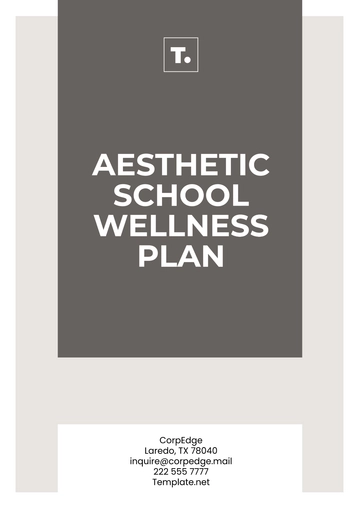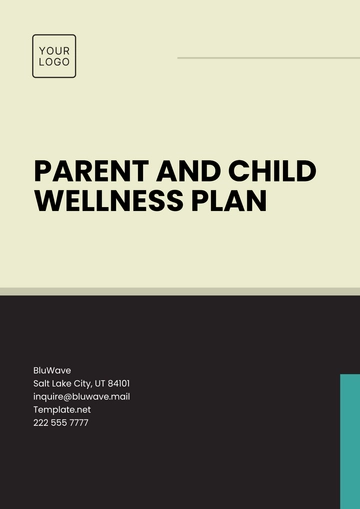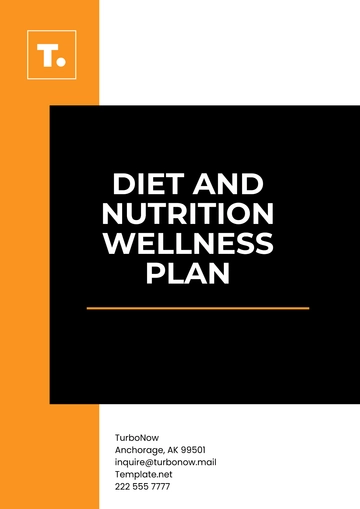Free Printable Middle-Aged Wellness Plan

Prepared by: [Your Name]
Company: [Your Company Name]
Date: [Insert Date]
I. Introduction
The Middle-Aged Wellness Plan is specifically designed for individuals aged 40-60, a life stage often marked by career achievements, family responsibilities, and the onset of age-related physical and mental changes. This plan aims to support and guide individuals through maintaining and improving their physical, mental, and emotional health during this critical phase. It integrates key strategies for managing health risks, boosting energy, maintaining work-life balance, and ensuring an active and fulfilling lifestyle well into the future.
II. Vision and Goals
A. Vision
To empower middle-aged individuals to take control of their health and well-being, promoting a balanced and fulfilling life that prioritizes longevity, vitality, and happiness.
B. Goals
Enhance Physical Health: Foster healthy practices to manage age-related changes and prevent chronic conditions.
Support Mental and Emotional Resilience: Provide strategies for managing stress, anxiety, and other mental health challenges, promoting overall emotional well-being.
Promote Healthy Relationships: Strengthen relationships with family, friends, and community, contributing to overall well-being and social connection.
Maintain Career and Personal Growth: Help individuals manage their career and personal life, focusing on achieving a healthy work-life balance.
Encourage Preventative Healthcare: Emphasize the importance of routine check-ups, screenings, and self-care practices to stay ahead of potential health issues.
III. Key Areas of Focus and Strategies
A. Physical Wellness
Strategies:
Exercise and Fitness: Engage in regular physical activity, including aerobic exercise (e.g., walking, swimming, cycling), strength training (e.g., weights, resistance bands), and flexibility exercises (e.g., yoga or stretching).
Goal: Aim for at least 150 minutes of moderate-intensity aerobic activity per week and two or more days of strength training.
Nutrition: Follow a balanced diet that includes nutrient-dense foods. Focus on high-fiber vegetables, fruits, lean proteins, whole grains, and healthy fats.
Goal: Minimize processed foods, reduce sodium and sugar intake, and ensure adequate hydration (aim for 8 cups of water per day).
Sleep Hygiene: Prioritize getting 7-9 hours of quality sleep each night. Create a calming nighttime routine and maintain a consistent sleep schedule.
Preventative Healthcare: Schedule regular health check-ups and screenings for blood pressure, cholesterol, diabetes, and cancer. Ensure up-to-date vaccinations and flu shots.
B. Mental Health and Emotional Well-being
Strategies:
Stress Management: Learn and practice relaxation techniques such as deep breathing, progressive muscle relaxation, or guided meditation to alleviate stress.
Goal: Incorporate relaxation practices daily to promote calmness and reduce overall stress levels.
Cognitive Health: Engage in brain-stimulating activities such as puzzles, reading, learning new skills, or taking courses to keep the mind sharp.
Goal: Dedicate time for cognitive exercises each week to support long-term mental agility.
Mental Health Support: Seek therapy or counseling if experiencing anxiety, depression, or overwhelming life stressors. Support groups and mental health resources can provide additional assistance.
Goal: Aim for regular emotional check-ins and seek support when needed.
Mindfulness Practices: Incorporate mindfulness techniques, such as journaling or mindful breathing, to foster emotional regulation and self-awareness.
C. Social and Relational Wellness
Strategies:
Building and Maintaining Relationships: Nurture healthy relationships with family, friends, and romantic partners. Engage in regular social activities that foster connection.
Goal: Aim for weekly social interactions, whether in person or virtually, to maintain strong bonds.
Community Engagement: Participate in community service, volunteering, or joining clubs to enhance your sense of belonging and purpose.
Goal: Find at least one community activity per month to join and stay socially active.
Effective Communication: Practice active listening and healthy communication skills to strengthen relationships and reduce conflict.
Goal: Regularly check in with loved ones and aim for clear, honest communication.
D. Career and Personal Development
Strategies:
Work-Life Balance: Set clear boundaries between work and personal time. Schedule regular breaks during the workday and ensure evenings and weekends are reserved for relaxation and family time.
Goal: Prioritize personal time and ensure a balanced approach to work commitments.
Skill Development: Continue to learn and grow in your career by pursuing new certifications, learning new skills, or exploring new job opportunities.
Goal: Set one personal or career development goal every 6 months to keep growing professionally and personally.
Retirement Planning: Review and adjust retirement savings plans to ensure long-term financial security.
Goal: Meet with a financial advisor annually to assess retirement readiness and adjust savings strategies accordingly.
E. Healthy Lifestyle Choices
Strategies:
Substance Use Management: Limit alcohol consumption and avoid smoking or recreational drug use. If struggling with substance use, seek help and support.
Goal: Follow recommended guidelines for alcohol consumption and seek professional help if needed.
Sexual Health and Wellness: Continue regular sexual health check-ups and communicate openly with partners about sexual health and expectations.
Goal: Maintain regular check-ups and stay informed about sexual health at every stage of life.
Financial Health: Budget, save, and invest wisely for the future, ensuring financial stability and security. Focus on reducing any high-interest debt.
Goal: Set aside a percentage of income each month for savings and retirement.
IV. Implementation Plan
A. Roles and Responsibilities
Wellness Coaches: Support and motivate individuals to follow their wellness plan, providing personalized advice on physical and emotional health.
Healthcare Providers: Conduct routine screenings, and physical exams, and provide ongoing care for chronic conditions.
Financial Advisors: Offer guidance on financial planning, retirement savings, and budgeting for the future.
B. Timeline
Phase 1 (Months 1-3): Conduct initial assessments and set wellness goals. Begin with small adjustments to exercise, nutrition, and mental health practices.
Phase 2 (Months 4-6): Continue to build healthy habits, focusing on consistency in exercise, eating well, and stress management techniques. Set new personal growth goals.
Phase 3 (Months 6-12): Solidify healthy habits and assess progress. Reevaluate goals and make necessary adjustments. Scheduled health check-ups and screenings.
Ongoing (12+ months): Maintain and refine wellness practices, setting new goals as needed for continued health and happiness.
V. Evaluation and Monitoring
A. Key Performance Indicators (KPIs)
Physical Health Improvements: Track progress in fitness, weight management, and adherence to healthy eating habits.
Mental Health and Emotional Well-being: Monitor stress levels, mood, and overall emotional resilience.
Social and Relational Wellness: Assess the quality and quantity of social interactions and community involvement.
Work-Life Balance: Track time spent on work versus personal activities, ensuring time for self-care and relaxation.
Financial Health: Monitor retirement savings, debt reduction, and overall financial security.
B. Methods of Evaluation
Surveys and Self-Reports: Regularly complete surveys to assess satisfaction with wellness goals and progress.
Health Check-ups: Schedule regular health assessments to evaluate physical and mental health progress.
Goal Tracking: Review personal and professional goals to track progress and adjust timelines and strategies as necessary.
VI. Sustainability Plan
A. Ongoing Support
Monthly Check-ins: Provide regular check-ins to ensure individuals remain on track with their wellness goals and offer additional resources or adjustments as needed.
Educational Workshops: Offer continued education on wellness topics such as nutrition, stress management, and financial health.
Support Groups: Facilitate support groups or community forums to foster continued engagement and motivation.
B. Funding and Resources
Health Insurance: Ensure individuals have access to affordable healthcare and necessary screenings.
Employee Wellness Programs: Encourage participation in employer-provided wellness programs or community initiatives.
Grants and Sponsorships: Seek funding or community partnerships to enhance wellness resources.
VII. Conclusion
The Middle-Aged Wellness Plan is a holistic and sustainable approach to promoting well-being during a pivotal life stage. By focusing on physical health, mental well-being, career growth, and personal development, this plan empowers individuals to lead a balanced, fulfilling life. With consistent effort and commitment, individuals can improve their quality of life, reduce health risks, and create a strong foundation for future health and happiness.
- 100% Customizable, free editor
- Access 1 Million+ Templates, photo’s & graphics
- Download or share as a template
- Click and replace photos, graphics, text, backgrounds
- Resize, crop, AI write & more
- Access advanced editor
You may also like
- Finance Plan
- Construction Plan
- Sales Plan
- Development Plan
- Career Plan
- Budget Plan
- HR Plan
- Education Plan
- Transition Plan
- Work Plan
- Training Plan
- Communication Plan
- Operation Plan
- Health And Safety Plan
- Strategy Plan
- Professional Development Plan
- Advertising Plan
- Risk Management Plan
- Restaurant Plan
- School Plan
- Nursing Home Patient Care Plan
- Nursing Care Plan
- Plan Event
- Startup Plan
- Social Media Plan
- Staffing Plan
- Annual Plan
- Content Plan
- Payment Plan
- Implementation Plan
- Hotel Plan
- Workout Plan
- Accounting Plan
- Campaign Plan
- Essay Plan
- 30 60 90 Day Plan
- Research Plan
- Recruitment Plan
- 90 Day Plan
- Quarterly Plan
- Emergency Plan
- 5 Year Plan
- Gym Plan
- Personal Plan
- IT and Software Plan
- Treatment Plan
- Real Estate Plan
- Law Firm Plan
- Healthcare Plan
- Improvement Plan
- Media Plan
- 5 Year Business Plan
- Learning Plan
- Marketing Campaign Plan
- Travel Agency Plan
- Cleaning Services Plan
- Interior Design Plan
- Performance Plan
- PR Plan
- Birth Plan
- Life Plan
- SEO Plan
- Disaster Recovery Plan
- Continuity Plan
- Launch Plan
- Legal Plan
- Behavior Plan
- Performance Improvement Plan
- Salon Plan
- Security Plan
- Security Management Plan
- Employee Development Plan
- Quality Plan
- Service Improvement Plan
- Growth Plan
- Incident Response Plan
- Basketball Plan
- Emergency Action Plan
- Product Launch Plan
- Spa Plan
- Employee Training Plan
- Data Analysis Plan
- Employee Action Plan
- Territory Plan
- Audit Plan
- Classroom Plan
- Activity Plan
- Parenting Plan
- Care Plan
- Project Execution Plan
- Exercise Plan
- Internship Plan
- Software Development Plan
- Continuous Improvement Plan
- Leave Plan
- 90 Day Sales Plan
- Advertising Agency Plan
- Employee Transition Plan
- Smart Action Plan
- Workplace Safety Plan
- Behavior Change Plan
- Contingency Plan
- Continuity of Operations Plan
- Health Plan
- Quality Control Plan
- Self Plan
- Sports Development Plan
- Change Management Plan
- Ecommerce Plan
- Personal Financial Plan
- Process Improvement Plan
- 30-60-90 Day Sales Plan
- Crisis Management Plan
- Engagement Plan
- Execution Plan
- Pandemic Plan
- Quality Assurance Plan
- Service Continuity Plan
- Agile Project Plan
- Fundraising Plan
- Job Transition Plan
- Asset Maintenance Plan
- Maintenance Plan
- Software Test Plan
- Staff Training and Development Plan
- 3 Year Plan
- Brand Activation Plan
- Release Plan
- Resource Plan
- Risk Mitigation Plan
- Teacher Plan
- 30 60 90 Day Plan for New Manager
- Food Safety Plan
- Food Truck Plan
- Hiring Plan
- Quality Management Plan
- Wellness Plan
- Behavior Intervention Plan
- Bonus Plan
- Investment Plan
- Maternity Leave Plan
- Pandemic Response Plan
- Succession Planning
- Coaching Plan
- Configuration Management Plan
- Remote Work Plan
- Self Care Plan
- Teaching Plan
- 100-Day Plan
- HACCP Plan
- Student Plan
- Sustainability Plan
- 30 60 90 Day Plan for Interview
- Access Plan
- Site Specific Safety Plan





























